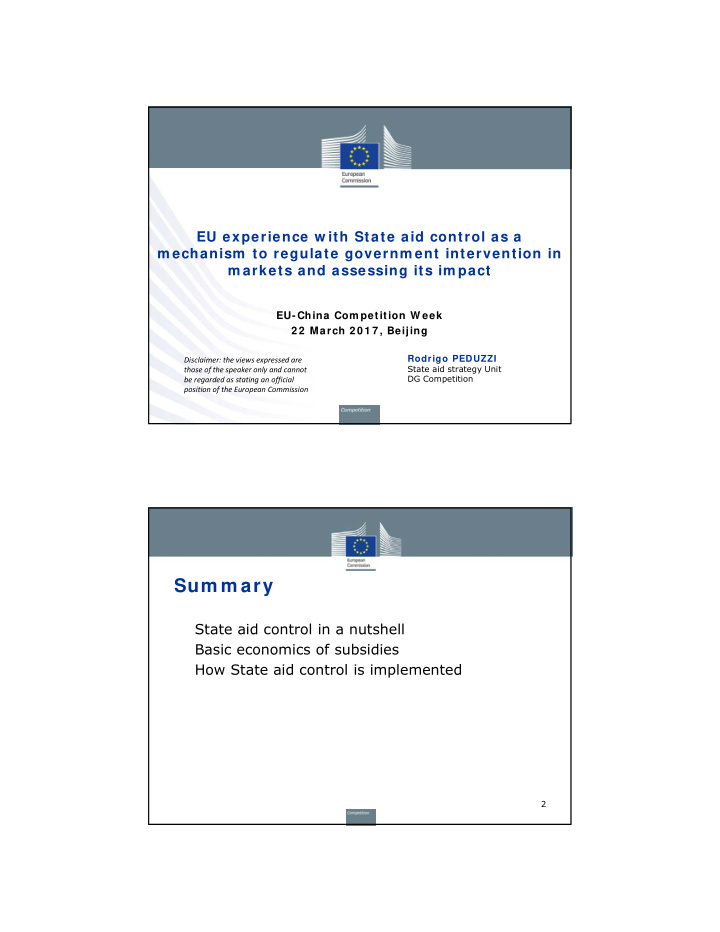



EU experience w ith State aid control as a m echanism to regulate governm ent intervention in m arkets and assessing its im pact EU-China Com petition W eek 2 2 March 2 0 1 7 , Beijing Rodrigo PEDUZZI Disclaimer: the views expressed are State aid strategy Unit those of the speaker only and cannot DG Competition be regarded as stating an official position of the European Commission Sum m ary 1. State aid control in a nutshell 2. Basic economics of subsidies 3. How State aid control is implemented 2
1 . State aid control in a nutshell 3 State aid control as one instrum ent of EU com petition policy 4
W hy do w e control State aid in the EU? EU internal market, level playing field between undertakings Role in liberalisation Competitive EU industry Avoid subsidy races between EU Member States Element of cohesion within the EU 5 W hat is State aid? 6
Lim its to the Notion of Aid • Activities exercising public power (e.g. army or police) Solidarity-based social security schemes Health care services based on the principle of solidarity Education and non-commercial research activities Most activities related to culture, heritage and nature conservation General measures (i.e. non selective ones) Market-conform investments Measures with no impact on trade 7 Notification requirem ent, and exceptions All new aid needs to be notified to the Com m ission before being granted by the Member States. it is covered by a block exemption regulation ( ) or by an approved scheme. Share of block exem pted aid 100% 90% 80% 70% 60% 50% 40% 30% 20% 10% 0% 2010 2011 2012 2013 2014 2015 2016 Total GBER reported SA expenditure as % of total reported expenditure 8 Total registered GBER cases as % of total registered cases
Procedure Sim plified version of the procedure 9 How the Com m ission assesses aid m easures: the Com m on Com patibility Principles 1. contribution to well-defined objective of common interest 2. need for state intervention 3. appropriateness of state aid as policy instrument 4. existence of incentive effect 5. proportionality of the aid amount (aid limited to minimum necessary) 6. avoidance of undue negative effects on competition and trade 7. transparency 10
2 . Basic econom ics of subsidies 11 Static econom ic effects of a subsidy Loss of econom ic efficiency that occurs w hen equilibrium for a good or service is not achieved or is not achievable 12
Export subsidies: sim ple w elfare effects = b+d 13 W elfare effects of export subsidies: Hom e country = − a − b = a+b+c = − b − c − d = -(b+d) Producers' surplus (a+b+c) implies a loss of welfare for consumers • in the subsidising country (-a-b) Moreover, the government has to pay for the subsidy –b-c-d • 14
Medium -term potential effects of subsidies • Especially in low-skills sectors, subsidies (to maintain employment, for instance) may lead to low mobility of the labour force and traumatic responses to structural adjustments • The more prescriptive subsidies are, the higher the probability of distortive consequences and difficult-to-reverse path dependence • Massive subsidies may lead to production overcapacity, affecting worldwide prices (if the subsidising country is large enough) 15 Rationale for international discipline/ control of subsidies The theory of international trade provides an economic rationale for • multilateral trade agreements When a country adopts a , other countries • may reproduce this approach, with possible “race to the bottom” may arise, forcing countries to consider disciplines • This requires the existence of an independent body, • which guarantees for investors and governments: e.g. agreements cannot be modified arbitrarily As showed by academic literature (Collie, 2000), this rationale applies also • to : when there are many countries, " the range of values for opportunity cost where the Nash equilibrium export subsidy is positive and the prohibition of export subsidies is beneficial is quite large " 16
3 . How State aid control is im plem ented 17 The Com m ission's com m itm ent to better regulation in State aid • Commission's efforts to improve the quality of EU policies and law-making • State aid rules: Preceded by im pact assessm ents Followed by evaluations Open public consultations of all stakeholders • are a crucial component of the assessment of State aid measures, guaranteeing a cooperative approach • Also, State aid rules and decisions are adopted by the w hole Com m ission (college of Commissioners from all EU Member States) after inter-service consultation (different policy perspectives, not only DG Competition's, are taken into account) 18
State aid to banks in the EU: responding to the financial crisis • 2007-2008 Global Financial Crisis: an exceptional, once-in- a-lifetime situation • Specific State aid rules adopted to effectively respond to the financial crisis • From 2007 until 2015, 112 banks in the EU, representing around • Commission approved restructuring plans for 56 of these banks • Commission's State aid policy response to the crisis was key for the 19 Rescue and restructuring aid: the m ost distortive form of aid Empirical studies show the importance of market entry/exit as • State support for troubled firms can impose a number of costs : • By preventing the exit of the recipient firm, or by freeing it from the need to restructure • as a response to financial distress, Rescue & Restructuring aid maintains an Indirect negative effect through its consequences on the incentives of firms: excessive • level of risk taken by potentially aided firms, lack of investments from rival firms : Member States may use aid • to ensure the continuation of domestic production, shifting the burden of adjustment to production facilities in other Member States • As a consequence, rules in this area are particularly restrictive , but have been instrumental in fostering the m odernisation of industrial sectors , especially in some 20 EU economies
各位有什么 问题,请随便发问。 21
Recommend
More recommend